Joy Neal Kidney's Blog, page 39
April 11, 2023
Dallas County Freedom Rock Selfies
Several of these selfies with the Dallas County Freedom Rock at Minburn have been such nice surprises!
I’m with Emina Hastings, the Nineteen14 Depot restaurant in the background. Dedication day of the Dallas County Freedom Rock, October 19, 2019. Emina took photos for me that day and also did my author photos for the Leora books. (Emina came to Iowa as a teenager with her family, refugees of the Bosnian War.)
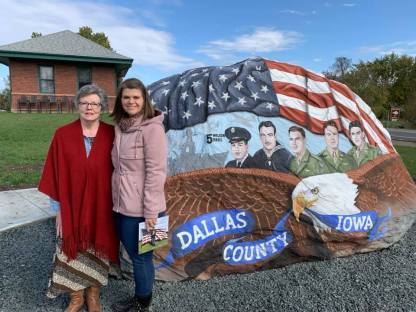
The Young Patriots Club sang at the dedication. You can see the young Wilson pilots among them.
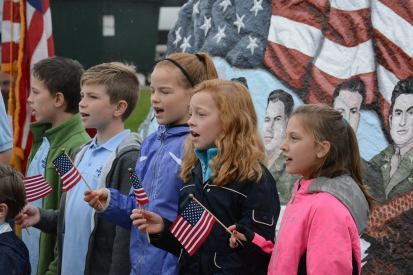
I have never met the first relative who visited the Freedom Rock, Clay Wilson from California, great great grandson of Delbert Wilson, who is the second brother from left on the Rock.
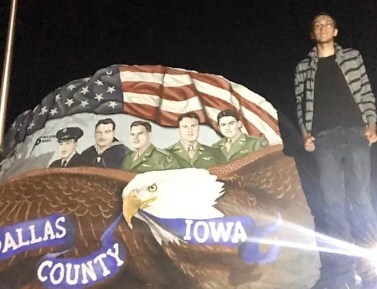
This popped up one day on Instagram, named only c6_crazy. When I told him how I was related to the brothers, he returned with his recumbent bike for a selfie. The Raccoon River Valley Bike Trail runs through Minburn.

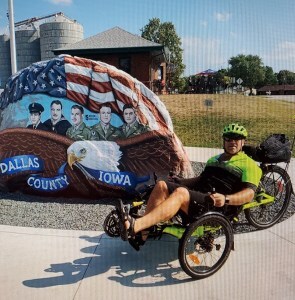
Steve Radakovich is a classmate from Earlham. He sent this one after reading Leora’s Letters.
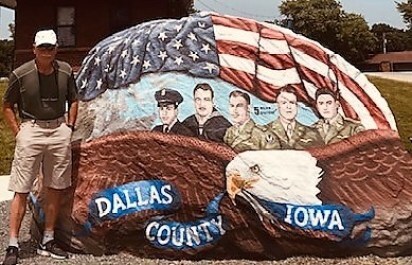
Rod Jensen read Leora’s Letters while wintering in Florida. After returning to northern Iowa, he read the Depression Era book and took a trip down to see the Wilson brothers on Minburn’s Freedom Rock.

One of my favorite Freedom Rock selfies is of Val Plagge and her children (one of them took the photo). Val is a very busy farmer, wife, mom, volunteer and blogger (Corn, Beans, Pigs, and Kids), but she took the time to read Leora’s Letters while in a tractor cab in the field, waiting on the combine!

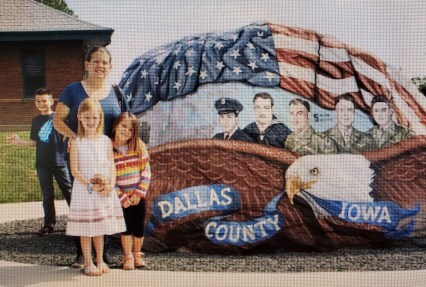
Alan Lovelady and the Des Moines Cycle Club (almost two dozen riders) visited the Dallas County Freedom Rock last weekend, riding into a strong headwind on their way back. “I’ve read and enjoyed three of your books, Joy. I even told the story to my biking companions today!”
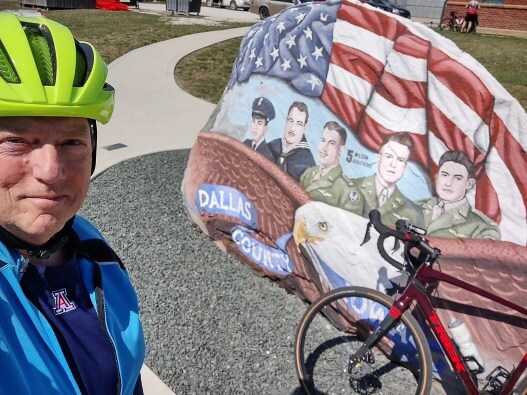
If you visit the Dallas County Freedom Rock at Minburn, I’d love it if you’d post a selfie with the Wilson brothers!
April 7, 2023
Unraveling Sunlight and Henry & Grace–Poems by Joe Barca
Unraveling Sunlight
 The Book: Unraveling Sunlight is a collection of poems that will make you think, make you feel, and let you breathe. It’s filled with magic and melancholy, whimsy and wonder. It’s a journey from darkness to light.
The Book: Unraveling Sunlight is a collection of poems that will make you think, make you feel, and let you breathe. It’s filled with magic and melancholy, whimsy and wonder. It’s a journey from darkness to light.

The Poet: Author of Unraveling Sunlight. Fast talker and slow runner. Husband. Father. Owner of a Wheaten Terrier. From New England. On Twitter @shepherdmoon53.
My Thoughts: The opening poems are raw, open with grief. “Empty” is especially poignant, as is “She’s Gone.” Thoroughly captivating are “My Haven” and the winsome “Nurture.” Five Stars!
Henry & Grace: A Love Story and Other Poetry
 The Book: This book is a collection of micro-poetry, a spill of sunlight that brushes your inner world and touches your emotional space. In addition, it includes a life long love story between Henry and Grace – a series of poems that stand alone and link together, a literary string of pearls.
The Book: This book is a collection of micro-poetry, a spill of sunlight that brushes your inner world and touches your emotional space. In addition, it includes a life long love story between Henry and Grace – a series of poems that stand alone and link together, a literary string of pearls.
My Thoughts: This charming book of poems is served to the reader for savoring in three parts: Micropoetry, Longer Poems, and Henry & Grace. There are about six dozen wisps of Micropoetry. My favorites are Grandmother, Mother’s Apron, New Years Eve, and Spring Rain. The Longer Poems, not much longer, are delectable morsels, especially the one named Gardens. Henry & Grace is a love story in poetry, with all of its fascinating ups and downs.
April 6, 2023
A Poet with Panache
Poet Mary Jedlicka Humston is an encourager extraordinaire.
A former high school teacher, Mary graduated from the University of Northern Iowa with a BA in English Education. She has had over 150 poems and essays published at the local and national level in newspapers, magazines, books, and online. One of her poems was chosen to be projected on the Krakow City of Literature UNESCO Poems on the Wall in 2014. Mary has presented programs on cancer, dealing with chronic illness, prayer, writing, and the Little Free Library movement. She is a member of National League of American Pen Women and The University Club Writers of Iowa City. She lives in Iowa City with her husband Jim.
I first met Mary at the Cedar Falls Christian Writer’s Workshop in 2016, where she was a presenter. She has been such a cheerful encourager for the “Leora stories.”
Leora’s Letters
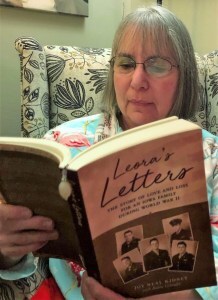 2019
2019“Leora’s Letters: The Story of Love and Loss for an Iowa Family During World War II by Joy Neal Kidney is an engrossing true story about an Iowa farm family during WW II.
“That Joy Neal Kidney is writing about her own family’s history makes it even more poignant. She includes many of the actual letters that were sent and received between many of her family members during the war.”
Leora’s Dexter Stories
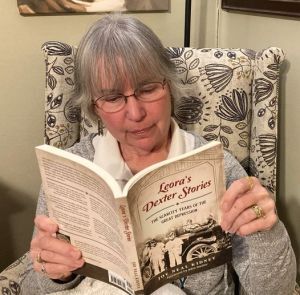 March 2022
March 2022“Leora’s Dexter Stories: The Scarcity Years of the Great Depression by Joy Neal Kidney was an enlightening read about an Iowa family (Joy’s relatives) in a small town as they navigated through a period in US History that tried the souls and hearts of communities everywhere. Kidney’s short stories give us a glimpse of how one family persevered through challenge after challenge yet retained hope for the future.
“I would highly recommend Leora’s Dexter Stories by Joy Neal Kidney.”
Leora’s Early Years
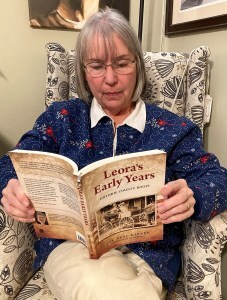 November 2022
November 2022“Really enjoying Leora’s Early Years: Guthrie County Roots by Joy Neal Kidney. The research by Kidney is meticulous and provides a clear background to the life of her grandmother Leora. She adds photos of her Iowa relatives and such detail to acquaint you with her family.
“(Her two other books center on Leora as well: Leora’s Letters: The Story of Love and Loss For An Iowa Family During World War II and Leora’s Dexter Stories: The Scarcity Years of the Great Depression.
“May you enjoy each book like I have!”
[image error]Mary brightens wherever she is. She regularly posts chalk encouragements in their driveway for anyone walking or driving by, as well as those of us who follow her on Facebook.
Mary coauthored a terrific book about letter writing with Mary Potter Kenyon called Mary & Me: A Lasting Link Through Ink.

April 5, 2023
Because of You Old Glory Flies by Julie Dueker

Because of You Old Glory Flies is a collection of heartfelt poems and illustrations to say thank you to all who have served, or currently serve in the United States military. In creating this book, Julie Dueker and Ray “Bubba” Sorensen II, a.k.a. The Freedom Rock Painter, have combined their unique talents and passions for God and country to show America’s heroes we are forever in their debt. They pray this book touches the hearts and lives of those who open it and share it.
 The author: Julie (Schmidt) Dueker is a Christian educator who loves sharing her passion for God, music, and patriotism with children of all ages. In 2017 and 2019, Julie was honored as Iowa’s VFW Elementary Teacher of the Year. Julie is the founder and director of Young Patriots Club, a Christian ministry of freedom–loving youth whose mission is to honor God and uplift American heroes. She and her young patriots perform at various events honoring heroes by reciting historical documents, singing patriotic songs, and sharing poetry, including the poems in this book.
The author: Julie (Schmidt) Dueker is a Christian educator who loves sharing her passion for God, music, and patriotism with children of all ages. In 2017 and 2019, Julie was honored as Iowa’s VFW Elementary Teacher of the Year. Julie is the founder and director of Young Patriots Club, a Christian ministry of freedom–loving youth whose mission is to honor God and uplift American heroes. She and her young patriots perform at various events honoring heroes by reciting historical documents, singing patriotic songs, and sharing poetry, including the poems in this book.
Julie and her husband, Craig, live in West Des Moines, Iowa, where they have been blessed with the honor of raising three amazing young men, Ryan, Josh, and Zach. Julie is grateful for the support of her family, friends, school family, and Young Patriots Club who share gratitude for God’s blessings upon our country, and those whose sacrifices secure our freedoms.
An Endorsement by Colonel Robert C. King (Ret):
“I’m impressed with Julie’s work to capture the essence of hero. There are heroes all around us and some we would never know served in our nation’s military to defend the rights and privileges that we hold dear. We can never repay them enough for all that they and their families have given to the rest of us. Many are in cemeteries across our land and overseas. Some didn’t return at all. Others live quietly in our communities continuing to give of themselves for the good of others. America’s greatness lies on the backs of our veterans and those who serve today. They have fought and died for us. I believe Julie’s works depict that very well.”
My thoughts: There are only eight poems in this collection of remembrance and gratitude for our volunteers in the American military, but they are powerful reminders of those who’ve served the rest of us. “Think of Me” emphasizes a reliance on God in whatever circumstances a warrior has found himself in. I enjoyed recognizing the illustrator’s children in one poignant drawing.
The illustrator is Ray “Bubba” Sorensen II, known across Iowa as the painter of the Freedom Rock north of Greenfield, but also of our Freedom Rocks, with the goal of one in every county. As the wife and daughter of military veterans and niece of several more, including three young airmen who lost their lives in WWII, I’m especially captivated by this collection of original poems by Julie Dueker. It’s a beautiful book to give as gifts.
Julie and the Young Patriots were part of the dedication of the Dallas County Freedom Rock at Minburn, Iowa, which remembers all five Wilson brothers.

You might like to visit Julie’s website.
—–

Julie Dueker as a guest on PJNET.tv. Her compelling interview begins about 3 minutes in. She talks about The Freedom Rocks, Young Patriots Club, and For You Old Glory Flies.
April 4, 2023
Where to Find Audubon County Places Named in the “Leora Stories”
Fans of the “Leora stories” have already been traveling to see where some of the stories took place, or to find places connected with the Clabe and Leora Wilson and their family. Here’s some help with places in Audubon County, Iowa. (I wish I could capture better maps for you!)
The Goff family lived in Audubon County only six years in the early 1900s, but several favorite family stories have come from that short time.
Melville #2 School
The Goff youngsters attended Melville #2 School. Leora completed 8th Grade at this country school.
Audubon County has collected funds to post signs where the rural schools were. I’ve sponsored one for Melville #2 but don’t know whether it’s been posted yet.
Audubon Piano Teacher’s House?
 Nora Brown Preston, fondly known as “Brownie,” had to resign her position with the Audubon school system in 1908 when she married. She still shared her music in her church and community, and also offered music lessons–voice, piano, and organ. Lessons–50 cents for half an hour–at the Preston home three doors east of the public school. Leora Goff rode a horse to Audubon to take piano lessons on Saturdays. Could this be the house? Where did the teenager tie her horse?
Nora Brown Preston, fondly known as “Brownie,” had to resign her position with the Audubon school system in 1908 when she married. She still shared her music in her church and community, and also offered music lessons–voice, piano, and organ. Lessons–50 cents for half an hour–at the Preston home three doors east of the public school. Leora Goff rode a horse to Audubon to take piano lessons on Saturdays. Could this be the house? Where did the teenager tie her horse?
Exira
Mrs. Connrardy’s Sewing School
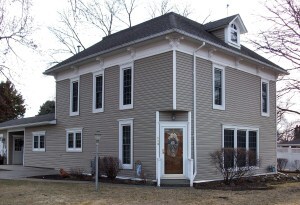 Susie Simpson, a great granddaughter of Alice B. Connrardy, shared a picture of the “sewing school house” as it looks today.I have not been there yet, so send me a selfie if you visit it!The house is on the corner of S. Edgerton and E. South Street. Turn south off the main street {which is actually Washington St and the highway that goes through Exira} onto S Edgerton at Exchange State Bank corner. It’s only 3 blocks and the house is on the south west corner of that intersection.
Susie Simpson, a great granddaughter of Alice B. Connrardy, shared a picture of the “sewing school house” as it looks today.I have not been there yet, so send me a selfie if you visit it!The house is on the corner of S. Edgerton and E. South Street. Turn south off the main street {which is actually Washington St and the highway that goes through Exira} onto S Edgerton at Exchange State Bank corner. It’s only 3 blocks and the house is on the south west corner of that intersection.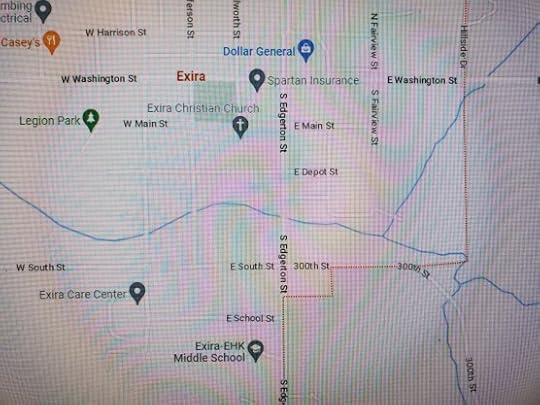
The Audubon and Exira libraries have a copy of Leora’s Early Years: Guthrie County Roots. I hope high school students will enjoy the short chapters in this book.
April 3, 2023
Rumble & Flash (poems) by C. A. Elliott, and So Much More
Chad Elliott, Poet

Chad Allen Elliott’s path to poetry began with a love of music. He has performed original songs across the U.S. for over 20-years, winning several awards for composition including the Woody Guthrie Songwriting Award in 2009. Early in his career, he learned some verses do not need musical embellishment. They stand alone in their own cadence. Since that time, Elliott has penned nearly 2,000 songs and released 22 albums.
In Rumble & Flash, Elliott shares poems composed during his time on the road. These poems are steeped in archetypal themes like fatherhood, love, nature, and spirituality.
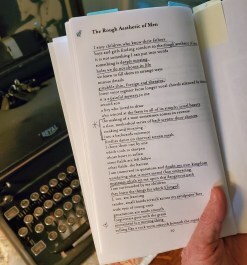 My thoughts: This is one of my favorite books of poetry. I especially like “The Rough Aesthetic of Men,” “One Harmful Thing,” “Refining Years,” and “Bur Oak.” I confess that I’ve got two copies. I hope to have the new one autographed, but my first one has been well-loved.
My thoughts: This is one of my favorite books of poetry. I especially like “The Rough Aesthetic of Men,” “One Harmful Thing,” “Refining Years,” and “Bur Oak.” I confess that I’ve got two copies. I hope to have the new one autographed, but my first one has been well-loved.
Hear Chad read the winsome opening poem, “Ringgold County,” on John Busbee’s “The Culture Buzz” program on KFMG-FM.
Chad Elliott, Artist
 Elliott is a graduate of Graceland University in Lamoni, Iowa, with a bachelor of arts in ceramics and has since collected graduate credits from the University of Montana in Missoula.
Elliott is a graduate of Graceland University in Lamoni, Iowa, with a bachelor of arts in ceramics and has since collected graduate credits from the University of Montana in Missoula.
At the Guthrie Grove Camp in Guthrie Center, Iowa, Elliott has created murals with youth. He has also created large murals for businesses including Shaky Tree Coffee and Farmers Trust & Savings Bank both in Spencer, Iowa. His recent mural work includes two 5 foot by 12 foot canvas paintings installed in 2012 in the newly renovated Spencer Community Theatre. He also completed a 16 foot by 40 foot landscape mural in 2013 on the side of Mohr Lumber in Coon Rapids, Iowa, to commemorate the town‘s sesquicentennial. In Pampa, Texas, Elliott installed a mural titled “This Land is Your Land” at the Woody Guthrie Folk Music Center.
Elliott Art Studio moved this year to Jefferson, Iowa. The building is still being remodeled. This year, Chad will be painting a mural for his hometown of Guthrie Center, Iowa.
Please check out Chad’s Art Studio website.
Chad Elliott, Musician
 Midwest singer-songwriter Chad Elliott blends folk roots, swampy blues and soulful writing to deliver an original Americana sound. His live performances have been honed over a decade of being on the road performing more than 200 shows each year. Elliott is lauded as “Iowa’s Renaissance Man” by Culture Buzz Magazine. He has penned more than 1,500 songs in his career while also cultivating his skills as a painter, sculptor, illustrator and author.
Midwest singer-songwriter Chad Elliott blends folk roots, swampy blues and soulful writing to deliver an original Americana sound. His live performances have been honed over a decade of being on the road performing more than 200 shows each year. Elliott is lauded as “Iowa’s Renaissance Man” by Culture Buzz Magazine. He has penned more than 1,500 songs in his career while also cultivating his skills as a painter, sculptor, illustrator and author.
Also his Music website.
Rumble & Flash (poems) by C. A. Elliott
Chad Elliott, Poet

Chad Allen Elliott’s path to poetry began with a love of music. He has performed original songs across the U.S. for over 20-years, winning several awards for composition including the Woody Guthrie Songwriting Award in 2009. Early in his career, he learned some verses do not need musical embellishment. They stand alone in their own cadence. Since that time, Elliott has penned nearly 2,000 songs and released 22 albums.
In Rumble & Flash, Elliott shares poems composed during his time on the road. These poems are steeped in archetypal themes like fatherhood, love, nature, and spirituality.
 My thoughts: This is one of my favorite books of poetry. I especially like “The Rough Aesthetic of Men,” “One Harmful Thing,” “Refining Years,” and “Bur Oak.” I confess that I’ve got two copies. I hope to have the new one autographed, but my first one has been well-loved.
My thoughts: This is one of my favorite books of poetry. I especially like “The Rough Aesthetic of Men,” “One Harmful Thing,” “Refining Years,” and “Bur Oak.” I confess that I’ve got two copies. I hope to have the new one autographed, but my first one has been well-loved.
Hear Chad read the winsome opening poem, “Ringgold County,” on John Busbee’s “The Culture Buzz” program on KFMG-FM.
Chad Elliott, Artist
 Elliott is a graduate of Graceland University in Lamoni, Iowa, with a bachelor of arts in ceramics and has since collected graduate credits from the University of Montana in Missoula.
Elliott is a graduate of Graceland University in Lamoni, Iowa, with a bachelor of arts in ceramics and has since collected graduate credits from the University of Montana in Missoula.
At the Guthrie Grove Camp in Guthrie Center, Iowa, Elliott has created murals with youth. He has also created large murals for businesses including Shaky Tree Coffee and Farmers Trust & Savings Bank both in Spencer, Iowa. His recent mural work includes two 5 foot by 12 foot canvas paintings installed in 2012 in the newly renovated Spencer Community Theatre. He also completed a 16 foot by 40 foot landscape mural in 2013 on the side of Mohr Lumber in Coon Rapids, Iowa, to commemorate the town‘s sesquicentennial. In Pampa, Texas, Elliott installed a mural titled “This Land is Your Land” at the Woody Guthrie Folk Music Center.
Elliott Art Studio moved this year to Jefferson, Iowa. The building is still being remodeled. This year, Chad will be painting a mural for his hometown of Guthrie Center, Iowa.
Please check out Chad’s Art Studio website.
Chad Elliott, Musician
 Midwest singer-songwriter Chad Elliott blends folk roots, swampy blues and soulful writing to deliver an original Americana sound. His live performances have been honed over a decade of being on the road performing more than 200 shows each year. Elliott is lauded as “Iowa’s Renaissance Man” by Culture Buzz Magazine. He has penned more than 1,500 songs in his career while also cultivating his skills as a painter, sculptor, illustrator and author.
Midwest singer-songwriter Chad Elliott blends folk roots, swampy blues and soulful writing to deliver an original Americana sound. His live performances have been honed over a decade of being on the road performing more than 200 shows each year. Elliott is lauded as “Iowa’s Renaissance Man” by Culture Buzz Magazine. He has penned more than 1,500 songs in his career while also cultivating his skills as a painter, sculptor, illustrator and author.
Also his Music website.
April 1, 2023
My Very First Blog Post was April 2, 2015
Hoping for a way to share old photos and stories, on April 2, 2015, I managed to publish my very first blog post. I started out with Weebly, but it was so frustrating to work with that when I had a chance to learn how to set up WordPress, I moved all my Weebly posts to WP. (That’s why it looks like I started blogging in 2017.)
The unexpected story behind that photo, which became that first post, five years later was the basis of Chapter 28 in Leora’s Dexter Stories: The Scarcity Years of the Great Depression, called “The Imbedded Needle.”
Needle in her Hand February 1935. Clabe had just sold the old Ford and bought the suit three months earlier, so he and Leora could “step out a little,” he wrote one of their Navy sons.
February 1935. Clabe had just sold the old Ford and bought the suit three months earlier, so he and Leora could “step out a little,” he wrote one of their Navy sons.My grandparents were all dressed up to go out, to a wedding maybe? Or a funeral? Clabe was in a three-piece suit, Leora in a dark dress and a hat with a little feather.
“Mom, do you know where your folks might have been going in this old picture?” I asked.
“Yes. Mom was going to have a needle taken out of her hand.”
I knew the needle story. Grandma was visiting us once when I was a girl and showed us that she couldn’t flatten out her right hand. We were cautioned never to leave a needle stuck in the arm of a couch.
Grandma told how she’d forgotten about the needle she used to repair things in the small town of Dexter, Iowa, then parked it in the bib of the apron she wore over her house dress. Her tub washer was broken so she scrubbed the laundry–for nine people–on a corrugated metal washboard. She felt a stab in the palm of her hand.
It happened so fast, she said. And it had broken off so she couldn’t get a hold of it to pull it out.
They had no extra money for a doctor but, Depression years or not, she needed one.
Dr. Chapler numbed her hand and fished around for the needle but couldn’t find it. He sent her home, said to soak the hand in hot water, and he’d get a time set up for x-rays at a hospital.
 Leora made a sketch of her hand when she wrote a letter to their Navy boys who were at Long Beach, CA, stationed on the USS Chicago. Letter dated Jan. 25, 1935, Dexter, Iowa.
Leora made a sketch of her hand when she wrote a letter to their Navy boys who were at Long Beach, CA, stationed on the USS Chicago. Letter dated Jan. 25, 1935, Dexter, Iowa.Leora didn’t think about how hot the water was. She couldn’t feel it. It burned the skin on her hand, so now they had to wait until the burn healed.
The day the picture was taken, Clabe and Leora were waiting for a ride to the hospital, which was an hour away.
The fragment of steel was located on the x-ray, but the doctor still had trouble finding it. When he managed to cut it out, Clabe said that her hand looked like a piece of meat.
Yes, in the picture, I can see that she’s holding her hand behind her. That’s the only clue.
“But why would they get all dressed up for that?” I asked.
Well, during those Depression years, Clabe had two sets of clothes–overalls and the suit. And Leora’s choices were her housework dress or this good one.
—–
Our American Stories, June 2021– an 8-minute story
Leora’s Dexter Stories: The Scarcity Years of the Great Depression

Where to Find Guthrie County Places Named in the “Leora Stories”
Fans of the “Leora stories” have already been traveling to see where some of the stories took place, or to find places connected with the Clabe and Leora Wilson and their family. Here’s some help with places in Guthrie County, Iowa. (I wish I could capture better maps for you!)
Rural Guthrie County
Frog Pond School
 This map shows Frog Pond School as well as the Morrisburg church and cemetery (see below). How I wish maps would turn out better!
This map shows Frog Pond School as well as the Morrisburg church and cemetery (see below). How I wish maps would turn out better!
[image error]Clabe, Rectha, and Alice Wilson attended Frog Pond School. One of Clabe’s schoolmates there was Wesley Clampitt, who became the Superintendent of the Dexter School when Clabe’s children attended there during the Great Depression. Part of the old foundation marks where the school stood.
Windy Gap
 The Liza Jane railroad track ran through Windy Gap east of Monteith. It was hard to locate.
The Liza Jane railroad track ran through Windy Gap east of Monteith. It was hard to locate.
Guthrie Center
The Guthrie Center Christian Church
The Guthrie Center Christian Church, where Laura Goff “learned to vote,” now houses the bell from the Monteith Church. Both Laura and daughter Leora worshiped there for decades. Address: 105 N 4th Street, Guthrie Center 50115
Home of Leora (Goff) Wilson and her mother Laura (Jordan) Goff
Address: 515 N. Fourth Street, Guthrie Center, 50115. It’s been remodeled and enlarged so it’s no longer recognizable as the little two-bedroom home of the widowed ladies.
Guthrie Center Cemetery
Leora’s folks, Sherd and Laura Goff, are buried there, as are Leora’s sister Georgia and brothers Rolla and Perry. Leora’s sister-in-law, who died of mumps when her baby boy was four days old (see page ) is buried there, as are the three Wilson infants who died at Dexter between 1929 and 1931. There is a stone there for Leora’s youngest brother, Virgil Cleon, but he is actually buried at Audubon.
The cemetery is east of the downtown area, on the north side of Highway 44. The Goff burial plot is at the east end of the cemetery, partway into the cemetery.
Rural Panora
Morrisburg Church
Georgia Wilson attended church there. Address: 2676 Wagon Rd, Stuart, IA 50250
P28 (or Wagon Road) runs south from Panora to Stuart.
Morrisburg Cemetery
The cemetery is along the Highway P28 (Wagon Road) south of the church. Clabe Wilson’s mother, Georgia, is buried here, as well as her folks, two sisters, grandparents, and many more Williams relatives. Her grandparents’ stone is located on the left as you drive in from the entrance.
Monteith
Cemetery
Located just west of the town, Leora’s Jordan, Moore, and Branson ancestors are buried in the area north of the road.
Stuart
Depot
 The Goffs and the Wilsons rode the Liza Jane train many times between Stuart and Guthrie Center. The Stuart Depot, right along White Pole Road, has been renovated and is in use for local activities. Commemorative bricks were sold as a fundraiser. Four Wilson bricks are part of the display near the depot. Address: 1193-1199 Front St, Stuart, IA 50250
The Goffs and the Wilsons rode the Liza Jane train many times between Stuart and Guthrie Center. The Stuart Depot, right along White Pole Road, has been renovated and is in use for local activities. Commemorative bricks were sold as a fundraiser. Four Wilson bricks are part of the display near the depot. Address: 1193-1199 Front St, Stuart, IA 50250
Please check local libraries for copies of Leora’s Early Years: Guthrie County Roots. I hope high school students will enjoy the short chapters in this book!

March 31, 2023
Where to Find Dallas County Places Named in the “Leora Stories”
Fans of the “Leora stories” have already been traveling to see where some of the stories took place, or to find places connected with the Clabe and Leora Wilson and their family. Here’s some help with places in Dallas County, Iowa.
Perry, Iowa
The Wilson burial place at the Violet Hill Cemetery is Perry is probably the most challenging to find. They are in the east section. As you turn north on the street that divides the cemetery, take the first right, through the arch with the name. Take the first left, follow that north to where the path divides. Stay to the right. Three slim evergreens are behind them to the east.
 Taken at Violet Hill Cemetery by a new fan of the Leora stories.
Taken at Violet Hill Cemetery by a new fan of the Leora stories.The Forest Park Museum near Perry has a large poster about the Wilson family. Remember the mailman who had to deliver the devastating telegrams to the Wilsons? There’s a display about him next to the Wilson poster, along with his early mail-delivery buggy.
The acreage the bought at the end of 1944 is on the next corner south of the museum. The little house was in bad shape the last time we drove by.
Minburn, Iowa
[image error]Taken by a new fan of Leora’s stories.All five Wilson brothers are remembered on the Dallas County Freedom Rock, right along Highway 169. Be sure to check out the storyboard nearby.
Just north of the Freedom Rock is the Nineteen14 restaurant, the restored 1914 railroad depot, frequented to Doris Wilson when she waitressed at Perry and rode back and forth to Minburn. (Address: 210 4th St, Minburn, IA 50167) The Raccoon River Valley Bike Trail runs right by the restaurant.
The farm where they were tenant farmers is just a couple of miles west of town, south of the bridge on Minburn Road along Lexington Lane. Because the house has been changed so much, I could not find it.
A museum in Washington Township School (Address: 18930 210th Street), where Danny and Junior graduated from high school, owns their diplomas and Danny’s pin for being valedictorian in 1941.
Dexter, Iowa
 “Grandmother’s House” still stands, along White Pole Road and across from the Dexter Park. A monument near the sidewalk names Dexter men who were combat casualties.
“Grandmother’s House” still stands, along White Pole Road and across from the Dexter Park. A monument near the sidewalk names Dexter men who were combat casualties.
The Dexter Methodist Church, where Leora and her mother were baptized, is two blocks south of “Grandmother’s House.”
The Dexter water tower, which Delbert climbed to tie his class colors, is easy to find. (Story on page 66 of Leora’s Dexter Stories: The Scarcity Years of the Great Depression)
The Dexter Public Library, along Marshall Street, is in the same place where Clabe Wilson worked on the 1939 WPA project to remodel it. (see pages 81 and 82) Earlier the doctors’ office was in that building. Doris saw Clyde Barrow’s brother Buck and his wife Blanche come out bandaged up after the Dexfield Park shootout in 1933.
 A block south and across the street is the Dexter Museum, where there is a large display about the Wilson family. They also own the Mrs. Potts sadiron which belonged to Leora’s mother, Laura Goff when she lived at Dexter.
A block south and across the street is the Dexter Museum, where there is a large display about the Wilson family. They also own the Mrs. Potts sadiron which belonged to Leora’s mother, Laura Goff when she lived at Dexter.
The 1916 Dexter Community Building, where the Wilson kids played basketball, is one block west of the library. It’s on the National List of Historic
Drew’s Chocolates has been in business since 1927. (see page 142) It’s still a popular stop along White Pole Road at the west edge of Dexter.
There’s a marker for Dexfield Park, where the 1933 shootout with Bonnie and Clyde happened, is a couple of miles north of Drew’s on Dexfield Road.
Please check your local library for copies of Leora’s Dexter Stories: The Scarcity Years of the Great Depression and Leora’s Letters: The Story of Love and Loss for an Iowa Family During World War II. I hope high school students will especially enjoy the short chapters in the Depression Era book.



